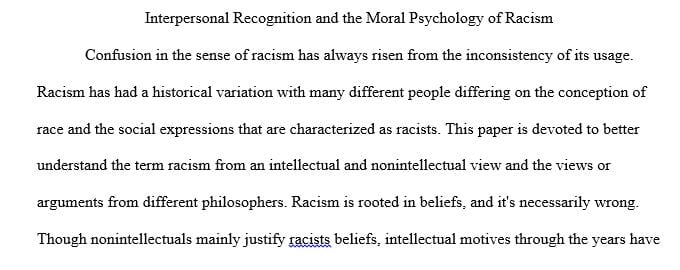Intellectualist and Anti-Intellectualist Conceptions of Interpersonal Recognition
Intellectualist and Anti-Intellectualist Conceptions of Interpersonal Recognition
What is the nature of our most basic awareness of others as human beings or persons with minds like ours? Does this state of mind consist ultimately in a kind of belief or in some non-intellectual stance (viz. some set of emotional/motivational stances towards others’ perspectives)? In other words, is an intellectualist or anti-intellectualist conception of interpersonal recognition the most plausible? Or should we opt instead for a hybrid account or some other account altogether? Why?
Key instructions:
The paper must be framed in terms of the intellectualist–anti-intellectualism dispute. You should choose one proponent of an intellectualist view (Bertrand Russell; I can also recommend a paper advocating a standard perceptual view of interpersonal awareness) and one proponent of an anti-intellectualism view (Peter Winch, Victoria McGeer, Jean-Paul Sartre, Raimond Gaita, Axel Honneth). Which view, if any, best captures the truth? What is the truth of the matter?
The paper must also partly be devoted to reflecting on the (supposed) critical function of the concept of interpersonal recognition. Plausibly, a theory of interpersonal recognition might give us a basis for normative criticism of certain attitudes toward other persons—if, for example, those attitudes involve a failure to recognize someone as a human being or person. Does your conception of interpersonal recognition allow for this, at least with respect to certain attitudes (e.g. objectifying attitudes or dehumanizing attitudes, in Livingstone Smith’s sense)? Why or why not? If not, do you think that this is a problem for your view of recognition?
Structure of the Long Paper
The long paper will be an argumentative essay which will have roughly the following structure:
Introduction: Briefly spell out (1) the topic of the paper, (2) the primary conclusion(s) for which you will be arguing, and (3) a step-by-step breakdown of what you do in the paper.
Exposition: Present and analyze the arguments/views of the figures with whom you engage.
Critical Argument: Attack or defend (parts of) the arguments/views of the figures in question.
Positive Proposal: Present your own positive views concerning the topic of the paper.
Constructive Argument: Provide arguments for your own views, making sure that you respond to actual or possible objections to your views (especially objections from these figures).
Solution preview for the order on Intellectualist and Anti-Intellectualist Conceptions of Interpersonal Recognition
APA
2735 words
